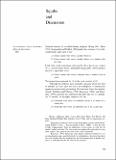An Antinomy about Anaphora
Author(s)
Almotahari, Mahrad
DownloadAlmotahari-2011-An Antinomy about Anaphora.pdf (60.69Kb)
PUBLISHER_POLICY
Publisher Policy
Article is made available in accordance with the publisher's policy and may be subject to US copyright law. Please refer to the publisher's site for terms of use.
Terms of use
Metadata
Show full item recordAbstract
Standard theories of so-called donkey anaphora (Kamp 1981, Heim
1982, Groenendijk and Stokhof 1991) predict that sentence (1) is truth conditionally
equivalent to (2).
(1) Every farmer who owns a donkey beats it.
(2) Every farmer who owns a donkey beats every donkey that he owns.
I will refer to the proposition expressed by (2) as the strong reading
of (1). A nonstandard theory, defended by King (1993, 2004), predicts
that (1) is equivalent to (3).
(3) Every farmer who owns a donkey beats a donkey that he owns. The proposition expressed by (3) is the weak reading of (1). Although the authors I have referred to disagree about how best
to interpret (1), they agree that (1) is not ambiguous; it semantically
expresses no more than one reading. Not everyone shares this opinion,
though. Schubert and Pelletier (1989), Kanazawa (1994), and Chierchia
(1995) suggested that sentences relevantly like (1) are ambiguous.
2 Consider, for example, sentences (4)–(6).
(4) Everyone who owns an umbrella leaves it at home on a sunny day.
(5) Everyone who owns an umbrella uses it on a rainy day.
Date issued
2011-07Department
Massachusetts Institute of Technology. Department of Linguistics and PhilosophyJournal
Linguistic Inquiry
Publisher
MIT Press
Citation
Almotahari, Mahrad. “An Antinomy about Anaphora.” Linguistic Inquiry 42 (2011): 509-517. © 2011 MIT Press.
Version: Final published version
ISSN
0024-3892
1530-9150